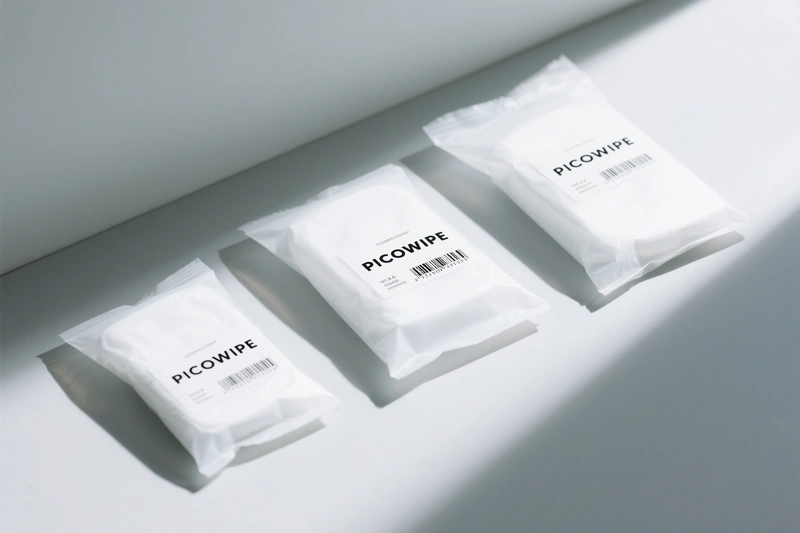By [email protected] — Charting the depths of expertise
When selecting a cleanroom wipe, basis weight (g/m²) is a core parameter that determines its performance, cost, and suitable applications. It refers to the weight of the fabric per square meter; a higher basis weight typically means the fabric is thicker and more densely fibered. Choosing the right basis weight is not about "the heavier, the better," but about precisely matching it to your specific needs.
I. Pros and Cons of High Basis Weight in Cleanroom Wipes
When comparing cleanroom wipes of the same material and construction, changes in basis weight lead to a series of predictable performance changes.
✅ Advantages of Higher Basis Weight:
Stronger Scraping and Cleaning Power: Denser fibers and a thicker structure act like a squeegee, effectively lifting and trapping stubborn contaminants like oil films and adhesives. Higher Absorption and Dirt-Holding Capacity: It provides more fiber surface area and internal voids to absorb and lock in more liquids (water, solvents) and dust particles. Lower Shedding Rate: Increased compression and bonding forces between fibers make them less likely to break or shed during use, reducing the risk of secondary contamination. Greater Durability and Abrasion Resistance: The thicker, more robust fabric is resistant to tearing and friction, making it suitable for use on rough surfaces or for repeated wiping, thus extending its service life.
While increasing basis weight enhances absorbency and dirt-holding capacity, the rate of performance improvement slows after a certain threshold, while costs continue to rise. This creates an optimal cost-performance range: 130g/m²–220g/m². PICOWIPE produces hundreds of cleanroom wipes and nonwoven wipes, and most mid-to-high-end applications fall within this range. In practice, wipes exceeding 220g/m² are rare (Note: models 7301 or 5009H are 240g/m²).
❌ Disadvantages of Higher Basis Weight:
Reduced Softness and Conformability: The fabric feels stiffer and less flexible, making it difficult to fully conform to irregular or intricate surfaces. Decreased Handling Flexibility: For cleaning tasks in tight spaces, an overly thick wipe can feel cumbersome and hinder operation. Significantly Higher Cost: Basis weight is directly linked to the amount of raw material used, leading to a substantial increase in cost.
II. Classification by Basis Weight
Based on performance differences, cleanroom wipes can be roughly divided into three tiers:
Lighter Wipes (approx. 90g/m² - 130g/m²)Core Features: Extremely lightweight and highly flexible, allowing them to conform perfectly to the most delicate and complex surfaces. They are easy to handle and have a lower cost. Applications: Cleaning surfaces with zero tolerance for scratches, such as optical lenses, semiconductor wafers, and precision instrument components. Additional Info: Products below 90g/m²are typically nonwoven cleanroom wipes, which have good absorbency but less strength and poorer shedding control than woven/knitted wipes, making them suitable for less critical applications. PICOWIPE currently has only one woven plain weave wipe under 90g/m², the MF-1, at 85g/m². Wipes under100g/m²are rare in the market, with the 3008 (95g/m²) or 3009 (100g/m²) sub-microfiber models being the most common (note: model numbers may vary by company).Medium-Weight Wipes (approx. 130g/m² - 180g/m²)Core Features: The optimal balance of performance and cost. This is the most mainstream choice on the market, offering good absorbency, durability, and a reasonable price. Applications: Has the widest range of applications and is the workhorse for most cleanrooms. Suitable for routine equipment surface cleaning, maintenance, solvent wiping, and disinfection tasks. Heavier Wipes ( > 180g/m², typically not exceeding220g/m²)Core Features: Needed for tasks requiring strong absorption and the removal of more substantial substances like liquids and oils. Applications: Handling large liquid spills and heavy grease; cleaning rough or abrasive equipment surfaces.
III. Application Scenarios for Different Basis Weights
For a more intuitive selection, refer to the table below:
| Cleaning Task | Recommended Basis Weight (g/m²) | Core Reason for Selection | Recommended Product Type & Notes |
|---|---|---|---|
| Wiping Optical Lenses / Wafers | 100 - 140 | Requires ultimate softness, low residue, and flexibility to avoid scratches and excessive solvent use. | Lightweight, knitted microfiber wipes with a rib knit pattern. |
| General Equipment Disinfection | 130 - 180 | Needs sufficient capacity to carry and remove disinfectants while balancing cost and efficiency. | Standard medium-weight knitted wipes. If shedding is not a concern, a more economical nonwoven wipe is an option. |
| Handling Moderate Liquid Spills | 160 - 200 | Requires excellent absorption speed and capacity, with a strong, tear-resistant body. | Mid-to-high weight knitted microfiber wipes. If shedding is not a concern, nonwoven wipes absorb faster. |
| Cleaning Rough / Abrasive Equipment | > 180 | Needs extremely high tear resistance and durability to extend its service life. | High basis weight woven wipes, as their structure is stronger than knitted wipes. |
| Cleaning Heavy Liquids/Oils from Precision Equipment | > 200 | Demands top-tier performance combining ultra-strong absorption, very high strength, and extremely low shedding. | Ultra-high basis weight knitted wipes (woven wipes have lower absorbency). |
Note:
Basis weight is not the only metric. It must be evaluated in conjunction with material (e.g., microfiber vs. standard fiber), construction (knitted vs. woven), edge sealing method (laser vs. ultrasonic), and other factors.


